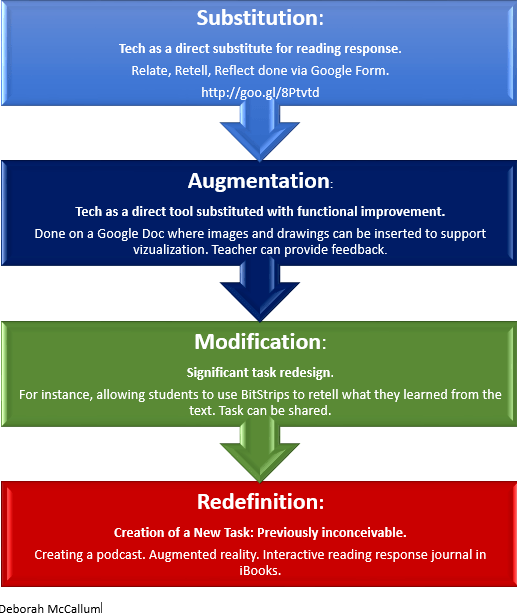The Components Of A Successful Online Learning Environment
Whether you are building an Online Learning framework for primary students, college students, or for professional development among your colleagues, the basic premise remain the same – the Online Learning Environment should enhance the learning potential of your candidates.
The SAMR model, created by Reuben Puentedura, is one example of how we can think about eLearning design. Just as with the SAMR, on one level eLearning Environments can be used as a direct replacement of what you would do in a physical environment. On another level, it could be an augmentation of those same tasks with audio and pictures. To take it to another level, eLearning Environments can also provide opportunities to modify tasks for deeper learning with technology. Finally, successful eLearning Environments will also inspire learners to redefine their tasks in ways previously inconceivable. The following is an example of my own interpretation of using eLearning to support reading responses.
Aside from the SAMR, other variables including age, curriculum, developmental level, learning needs and interests should be considered when adapting Online Learning Environment components for learners. For instance, when using a Learning Management system for primary students, it is most helpful if it is more visual based with lots of icons. Educators should also focus on fewer key features when working with younger learners. Often, it is very difficult for primary students to navigate and understand because it requires abstract thought. As learners progress and develop, more features can be added depending upon learning needs.
By contrast, online learning courses for higher education tend to be very textual based. We assume that this works best for adults, but the truth is that visualization is a powerful tool for comprehension, and it would be a mistake to assume that our older learners do not need visuals to support learning.
The following list contains 6 important components of a successful Online Learning Environment:
- Curation and addition of your own resources.
Educators spend a lot of time reading, researching, and getting involved with other educators in online Professional Learning Networks. This paired with personal experiences can lead to the curation of important resources that support the learners and learning goals of the course. - Supplement text-heavy environments with other types of resources.
Use interactive and visual resources to engage your learners and promote deeper levels of comprehension. Web 2.0 multimedia including live chats can help move beyond the structured discussion threads to real-time dialogue and sharing. It also promotes innovative ideas and the integration of past experiences and knowledge. - Encourage and Model Participation.
Just as in physical environments, participation in Online Learning Environments can be encouraged when the instructor explicitly sets clear expectations surrounding participation. Other strategies include modelling what effective participation looks like or sounds like, posting clear information in different sections to make it readily available, providing ongoing formative feedback through discussion posts, emails, and timely summative feedback. Further, asking effective questions and accepting of new ideas also helps candidates take risks to think critically and develop their ideas online. - Gradual Release of Responsibility.
Modelling and connecting with all candidates on a regular basis is essential. However, as the course continues the hope is that you have gradually helped participants to build a culture that supports higher order thinking and supportive environments that can self-sustain themselves without direct intervention. These relationships become responsible for supporting participation and deeper learning within the course. - Summarizing.
This is a comprehension strategy that is essential to assessing success with eLearning. It is important to help candidates summarize key points of learning. It is also important for participants to see their key strategies and ideas shared and have them reinforced. This promotes deeper learning. - Assessment.
Feedback and assessment is ongoing. It is timely, it is constructive, and it models effective practices. It usually works best when there are no clear marks. One strategy is to keep a running spreadsheet of each participant to record important information. Keeping track of this information also provides you with windows into patterns and learning gaps that you can help learners fill.
Online Learning is an evolving craft that requires sound pedagogy. We are on a journey of discovery as we practice and hone in on and I am also on a journey of discovery and learning to find the best pedagogical practices for the learners that we work with. Differentiation is always key, in addition to being respectful of the different cultures, experiences, and ideas that each person brings to the Online Learning Environment.


